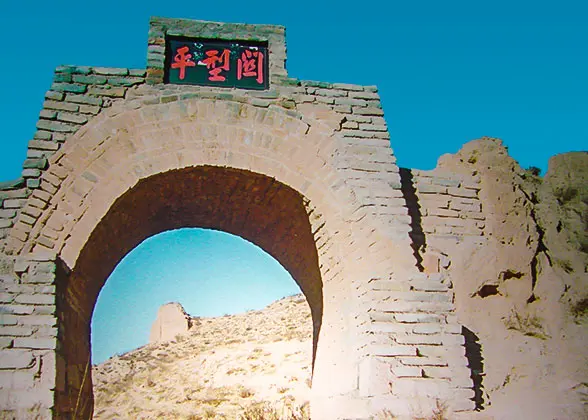Pingxing Pass (Pingxingguan)
 |
| Pingxing Pass of Great Wall |
The Pingxing Pass of the Great Wall occupies a strategically important position with Hengshan Mountain standing loftily to the north, and Wutai Mountain to the south. Standing along an ancient road which connects the Yanmenguan Pass in the west and the Zijingguan Pass in the east, the Pingxingguan Pass was a busy thoroughfare in the northern area of Hebei Province and Shanxi Province in the past, and also a point of battle during wartime.
"Pingxingguan" literally means a vase-shaped pass. It was named so because the terrain there resembles a vase. The mountains on two sides are quite high and precipitous, forming a great barrier to transportation. Thus, the lowland between the mountains is a convenient and energy-saving road. The Pingxingguan was built at a hump on the lowland, making it a geographically important military stronghold.
The Pingxing Pass was constructed in 1511 during the Ming Dynasty (1368-1644), so it has a history of more than 500 years. Basically in a square shape, it has a girth of 0.6 mile (1 kilometer) and three gates: the North Gate, the East Gate and the South Gate. Over the East Gate hangs a tablet which reads "Pingxing Pass". Magnificent barbicans were constructed outside these gates. As time has passed, only the northern barbican remains. To the south of the pass, there were two beacon towers to send military messages. Inside the pass, there were yamens, government offices of the past. Now, they have been transformed into dwellings.
The pass was renovated from May, 2014 to July, 2015. Only some necessary reinforcement was added, thus retaining its original beauty. Today you can see the pedestal and the gate tower. The pedestal is made of blue bricks. The gate tower is in traditional Chinese style, with red pillars and overhanging eaves.
Owing to its unique location, many battles were fought here. The most famous is the Battle of Pingxingguan, which took place on September 25, 1937. In this fierce battle, the Chinese army defeated a force of Japanese troops. It is regarded as one of the key battles of the Sino-Japanese War. You can find many sites of the battle close by. Qiao Gou is the site of the main battlefield, and Laoye Temple is where the fiercest fight occurred.
Also, you can see a memorial hall opposite the Laoye Temple, which was built in 1970 in memory of the heroes. In front of the memorial hall is a sculpture complex of the major generals. Behind the sculpture complex, you can see tall granite steles that are engraved with the comments of some leaders on the battle. Entering the memorial hall, you can see some marching maps, operation maps, and statues of major commanders. There are also some historical relics on display, such as kerosene burners, straw sandals, worn uniforms, iron pots, and outdated weapons. Seeing these items, you will think of war, and ponder over the value of peace.
It is located in Baiyatai Town, Lingqiu County, Datong, Shanxi Province. Starting from Datong Long-Distance Bus Station at No. 3, Weidu Avenue, you may take a bus to Lingqiu. There are about 35 departures a day from 06:30 to 18:00 with an interval of about 15-20 minutes. Duration is about 2.5 hours and the fare is about CNY 40. Upon arrival, go to Lingqiu Armed Forces Department and take a shuttle bus to the site.
Pingxingguan- A Pass with Strategic Location
The Pingxing Pass was constructed in 1511 during the Ming Dynasty (1368-1644), so it has a history of more than 500 years. Basically in a square shape, it has a girth of 0.6 mile (1 kilometer) and three gates: the North Gate, the East Gate and the South Gate. Over the East Gate hangs a tablet which reads "Pingxing Pass". Magnificent barbicans were constructed outside these gates. As time has passed, only the northern barbican remains. To the south of the pass, there were two beacon towers to send military messages. Inside the pass, there were yamens, government offices of the past. Now, they have been transformed into dwellings.
The pass was renovated from May, 2014 to July, 2015. Only some necessary reinforcement was added, thus retaining its original beauty. Today you can see the pedestal and the gate tower. The pedestal is made of blue bricks. The gate tower is in traditional Chinese style, with red pillars and overhanging eaves.
Battle of Pingxingguan
Also, you can see a memorial hall opposite the Laoye Temple, which was built in 1970 in memory of the heroes. In front of the memorial hall is a sculpture complex of the major generals. Behind the sculpture complex, you can see tall granite steles that are engraved with the comments of some leaders on the battle. Entering the memorial hall, you can see some marching maps, operation maps, and statues of major commanders. There are also some historical relics on display, such as kerosene burners, straw sandals, worn uniforms, iron pots, and outdated weapons. Seeing these items, you will think of war, and ponder over the value of peace.
How to Get to Pingxing Pass
- Last updated on Aug. 06, 2025 by Gabby Li -